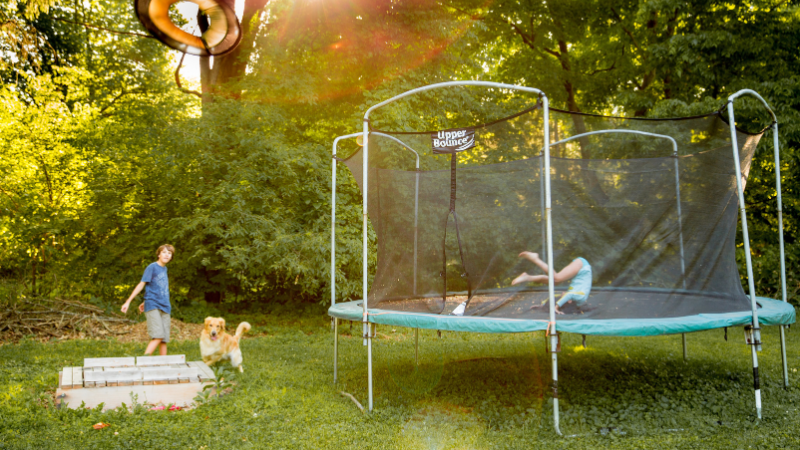As fitness enthusiasts, we know how difficult it can be to work out during the day. With tight schedules and ever-present responsibilities, finding time to go to the gym can quickly become impossible. But what if you didn't have to leave home? What if you could bring the gym to you instead?
Investing in a home gym might be your ticket to achieving your fitness goals without leaving home. But is it worth the investment? In this guide, we examine the pros and cons of home gyms and help you decide whether creating your own fitness space is the right move.
Benefits of a Home Gym
Creating a home gym offers numerous benefits, catering to various fitness goals and lifestyles. Even then, choosing equipment wisely while maintaining discipline and motivation to ensure consistent use is essential. Here are some advantages of having a home gym:
Pro #1 - Convenience
A home gym means no more rushing to the local fitness centre during peak hours. You can work out whenever you want, whether early morning or late at night. No more waiting for the treadmill or sharing weights with sweaty strangers. You also do not have to battle traffic or wait for the next bus to get to the gym, saving you time and stress.
Pro #2 - Privacy
Privacy is a luxury that home gyms offer. You won’t have to worry about judgmental glances or self-consciousness while trying new exercises. It’s just you, your favourite tunes, and your fitness goals. Home gyms allow you to focus on your form and channel your inner athlete.
Pro #3 - Customisation
Your home gym is your canvas for your fitness journey. You get to choose the equipment, layout, and ambience. You can hang motivational quotes on the walls and infuse the air with the fragrance of eucalyptus.
Whether you’re in the mood for high-intensity interval training (HIIT) or a low-intensity workout, the freedom to choose your workout, crank up the music, and dance between sets is yours.
Pro #4 - Long-Term Savings
While setting up a home gym requires a significant initial investment, it pays off in the long run. There are no monthly gym fees or commuting costs to your local gym, and your equipment becomes an asset that appreciates over time. We recommend calculating the savings over the next few years as you assemble the equipment for your fitness space.
Pro #5 - Timing
Early bird or night owl? With a home gym, you set the schedule. Whether it’s a sunrise yoga session or a midnight treadmill run, the choice is yours. Imagine it’s 10:30 PM, and you’ve had a busy day. Guess what? Your home gym is always open.
You can slip into your workout gear, hit play on your favourite playlist, and start your evening session. No judgment, no time constraints—just pure movement, self-care, and improved well-being.
Pro #6 - Hygiene
Say goodbye to sweaty benches and mystery odours. A home gym allows you to control the cleanliness of your space, ensuring a hygienic workout environment. When you wipe down the bench after your sweaty session, you don't have to deal with anyone else’s sweat or communal germs.
Pro #7 - Saves Travel Time
A home gym saves physical travel time and contributes to mental well-being and productivity. You do not need to drive to a fitness centre, find parking, or wait for equipment. You can now spend your commute time exercising.
When your gym is within your home, you’re likelier to stick to a regular workout schedule, as no external factors (like traffic or weather) can disrupt your routine. Over weeks and months, those saved minutes add up, reclaiming valuable time to spend with loved ones, pursue hobbies, or relax.
Pro #8 - Group Fun
One downside of having a home gym is its solitude. To overcome this, invite friends for a group workout or challenge your family to a fitness game. Your home gym can be a shared hub for health, which can be an effective way for families to bond with their partners and children.
Disadvantages of a Home Gym
While building a home gym has many advantages, there are also potential disadvantages. When deciding whether a home gym is right for you, weigh the potential disadvantages against the benefits, your personal preferences, lifestyle, and fitness goals.
Con #1 - Cost
Let’s address the elephant in the room: home gyms can be expensive. Quality equipment, from dumbbells to treadmills, comes with a price tag. However, as this is often only an initial cost, we recommend considering it an investment in your health and well-being.
Con #2 - Space Constraints
Not everyone has a spare room to transform into a gym. If you’re tight on space, you’ll need to get creative. Consider using foldable equipment or underutilised corners in your home to build an exercise space.
Con #3 - Motivation
Staying motivated can be challenging without the energy of a group class or the encouragement of a personal trainer. Skipping a workout is easy when your couch is just a few steps away. For most people, this is the major con of investing in a home gym, i.e., a higher investment upfront that yields little outcome as you lose your drive and motivation.
Con #4 - Maintenance
Home gyms require maintenance, such as dusting off equipment, checking for wear and tear, and keeping things organised. If you’re not up for the upkeep, a gym membership might be a better option.
How Much Does It Cost to Setup a Home Gym?

Setting up a home gym can be a rewarding investment in your health and well-being. Depending on your budget and space constraints, here's what you can expect:
- Budget-Friendly Approach: You can start a home gym with minimal expenses by using items you already have lying around. Think yoga mats, resistance bands, and even sturdy chairs for bodyweight exercises. This approach costs little to nothing.
- Basic Home Gym: If you’re looking for a more comprehensive setup, expect to spend around $300 to $500. This budget will cover essentials like dumbbells, a stability ball, and perhaps a jump rope.
- Mid-Range Setup: For a well-rounded home gym experience, allocate $1,000 to $2,000. This range allows you to invest in quality equipment such as adjustable benches, resistance machines, and a decent cardio machine (like a treadmill or stationary bike).
- High-End Home Gym: If you’re committed to creating a top-tier fitness space, be prepared to spend $5,000 to $15,000. This includes robust power racks, barbells, weight plates, and cardio equipment.
Now, let’s put this into perspective. Imagine paying an average of $44 per month for a gym membership. Over time, this adds up. If you opt for a well-equipped home gym, which costs around $1,500, it will take under three years to recoup the costs compared to a gym membership.
Read our guide on how to build a home gym with all basic equipment but still within your budget.
How Much Space Do I Need for a Home Gym?
Creating a home gym involves more than just dumbbells and enthusiasm—it’s about finding the right balance between functionality and space. Let’s explore the dimensions you’ll need for your very own fitness space:
1. Minimum Space: 40 Square Feet
You can get by with as little as 40 square feet for a basic home gym. Imagine an area approximately 8 feet long by 5 feet wide by 8 feet overhead. In this compact space, you can lay down a yoga mat, place some free weights, and even add a mirror for form checks.
2. Average Home Gym Size: 100 to 250 Square Feet
Most home gyms are between 100 and 250 square feet. This size accommodates cardio machines (like treadmills) and muscle-building equipment (dumbbells, benches, etc.). Adjustments may be needed, but it’s a versatile space.
3. Ideal Home Gym Sizes: 400 to 500 Square Feet
Aim for 400 or 500 square feet if you're dreaming big. Here’s why:
- Plenty of Options: With 500 square feet, you have room for weightlifting, cardio gear, and even a mini fitness party with friends or family.
- Squat Racks and Power Cages: A 400-square-foot gym can comfortably house a squat rack or power cage. You’ll also have space for storage shelves, exercise balls, and free weights.
Remember, the right size depends on your fitness goals, equipment preferences, and available space.
You can use pool exercise equipment to turn your pool into an effective place to work out; find out the possible options and equipment to implement a pool gym at home.
Basic Equipment List for a Home Gym

When setting up a home gym, choosing equipment that caters to your fitness needs and budget is essential. Here are some basic pieces of exercise equipment that I recommend for a well-rounded home workout:
- Adjustable Dumbbell Set: Dumbbells are versatile and allow you to target various muscle groups. An adjustable set saves space and lets you adjust the weight as needed.
- Resistance Bands: These bands provide variable resistance for strength training. They’re lightweight, portable, and great for toning muscles.
- Jump Rope: A simple yet effective cardio tool. Jumping rope improves cardiovascular fitness, coordination, and burns calories.
- Exercise Mat: Whether for yoga, bodyweight exercises, or stretching a comfortable mat provides cushioning and stability.
- Core Sliders: These small discs challenge your core stability during exercises like mountain climbers and lunges.
- Medicine Ball: Ideal for strength training, medicine balls can be used for squats, lunges, and rotational exercises.
- Kettlebell: A versatile tool for strength training, kettlebells allow you to perform various exercises like swings, squats, and Turkish get-ups. Start with a moderate weight and gradually progress as you build strength.
- Pull-up Bar: Installing a pull-up bar at home provides an excellent upper body workout. Pull-ups engage your back, arms, and core muscles. Look for a sturdy bar that can be mounted on a door frame or attached to a wall.
- Squat Rack: A squat rack is a must-have for weightlifting enthusiasts. It allows you to safely perform squats, bench presses, and overhead presses. Choose an adjustable rack that accommodates different barbell heights.
Remember, you don’t need an elaborate setup to stay fit at home. Start with these basics, and gradually expand your home gym as you progress.
Advanced Equipment List for a Home Gym

Cardiovascular exercise is crucial for overall health. Consider investing in a treadmill, stationary bike, or rowing machine if you're ready to invest in advanced home gym equipment. Here are other examples:
- Rowing Machines: Rowing machines, also known as ergometers or simply rowers, are exercise equipment designed to simulate the motion of rowing a boat. They offer a full-body workout, engaging both upper and lower muscle groups. Find the best home rowing machines in Australia.
- Elliptical Cross Trainers: These machines combine running, cycling, and stair climbing benefits. They are low-impact and great for cardiovascular conditioning. Look for stability, adjustable resistance, and comfortable handles. Here are the best elliptical cross trainers in Australia.
- Treadmills: Treadmills have various features like incline settings, pre-programmed workouts, and heart rate monitoring. Pick the best treadmill in Australia that suits your preferences, space, and budget
- Under-Desk Treadmills: If you have limited space, consider an under-desk treadmill. These compact units allow you to walk or jog while working at your desk. For staying active during long work hours, here are the best under-desk treadmill options.
- Exercise Bikes: Exercise bikes effectively improve cardiovascular fitness, build strength, and burn calories. They allow you to cycle indoors, providing a convenient workout option. Our guide handpicks the best home exercise bike in Australia.

Conclusion
In the end, the worth of a home gym depends on your commitment, lifestyle, and budget. If you’re passionate about fitness, willing to invest, and crave convenience, a home gym could be your secret weapon to a healthier you.
So, grab those dumbbells, put on your favourite workout gear, and let’s break a sweat—right in the comfort of your home.








